
From AR Coatings to Notch Filters, and from TCOs to DBRs, Evatec offers customized coating platforms and complete process solutions based on enhanced evaporation and sputter.
Phone: (603) 669-9656
www.evatecnet.com
E-Mail:infoNA@evatecnet.com
|
64 CFM List $8,250
3 to 64 CFM, 6 to 108 m3/hour. All voltages, 1 and 3 phase. Fomblim/Krytox available. 2 year parts & labor warranty, satisfaction guaranteed.Prices and Complete Specs at:
|

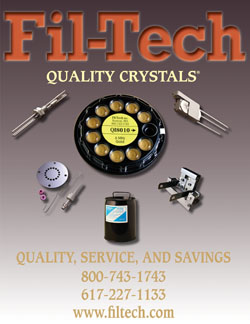
Fil-Tech's New 2013 Catalog Fil-Tech's Quality Crystals® Gold, Longer Life Gold, and Alloy 6MHz and 5MHz styles. Fil-Tech supplies rate monitors, sensorheads, feedthroughs, ebeam and ion source parts. Fil-Tech's FT704 replaces DC704. Call for catalog and Technical Bulletins. Fil-Tech, Inc. 617-227-1133 or 800-743-1743 www.filtech.com paula@filtech.com |
 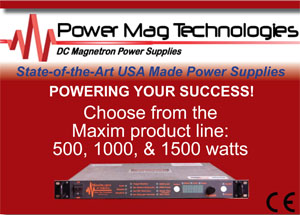
THREE STEPS TO SUCCESS
Power Mag Technologies now offers 3 different power levels of DC Magnetrons to enhance your sputtering process with the Maxim line of power supplies.
Contact: 877.513.3295
|
 
Thin-Films Research is prepared to meet your custom thin-film coating requirements. Using state-of-the-art equipment and over 40 years of experience, Thin-Films Research offers technology for the electro-optics, semiconductors, sensors & medical electronic industries. Learn More
Thin-Films Research, Inc.
270 Littleton Road
Westford, MA 01886
Phone: 978-692-9530
Fax: 978-692-9531
E-Mail: sales@thinfilmsresearch.com |

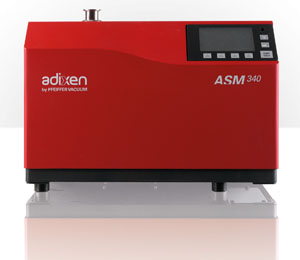
Fast Leak Detector
The ASM 340 is an easy-to-use, high performance and durable leak detector that provides high throughput. It performs He/H leak detection in both vacuum and sniffing modes.
Learn More.
Pfeiffer Vacuum, Inc. Phone: 603-578-6500 Toll Free: 800-248-8254 Web site: www.pfeiffer-vacuum.com contact@pfeiffer-vacuum.com |
UHV Metal Bellows
BellowsTech edge welded metal bellows are manufactured for ultra-high vacuum and positive pressure applications, and can provide the mechanical movement required for any application. Learn more.
BellowsTech, LLC
Visit Us Online
Phone: 386-615-7530
|

Smart solutions for surface technology from Bürkert - perfect for optimal process yields, high quality and peace of mind.
Bürkert. We make ideas flow.
Bürkert Werke GmbH
Maik Lösel
Segment Manager Gas
Christian-Bürkert-Str. 13-17
74653 Ingelfingen, Germany
Phone: +49 35952 36 362
Email: maik.loesel@burkert.com
|

The Hiden HPR-30 is a residual gas analyser configured for analysis of gases and vapours in vacuum processes and for vacuum diagnostics.
Learn more.
|

Temescal Systems & Components
Industry leaders choose Temescal for our unparalleled expertise in electron beam coating system and component solutions. Embrace the cloud.
Learn more.
http://www.temescal.net
(800) 522-1215
email: temescalinfo@ferrotec.com
|
 One-week Course One-week Course in the Practical Design and Production of Optical Thin Films October 14-18
Charleviox, MI USA
Comprehensive and Comprehensible!
|


USB-Powered Reflectometer for Thin-Film Measurement
Quickly measure thickness and index of single- and multi-layer films using aRTie, which simultaneously measures reflectance and transmittance.
Learn more.
Filmetrics, Inc.
Phone: 858-573-9300
www.filmetrics.com
info@filmetrics.com
|

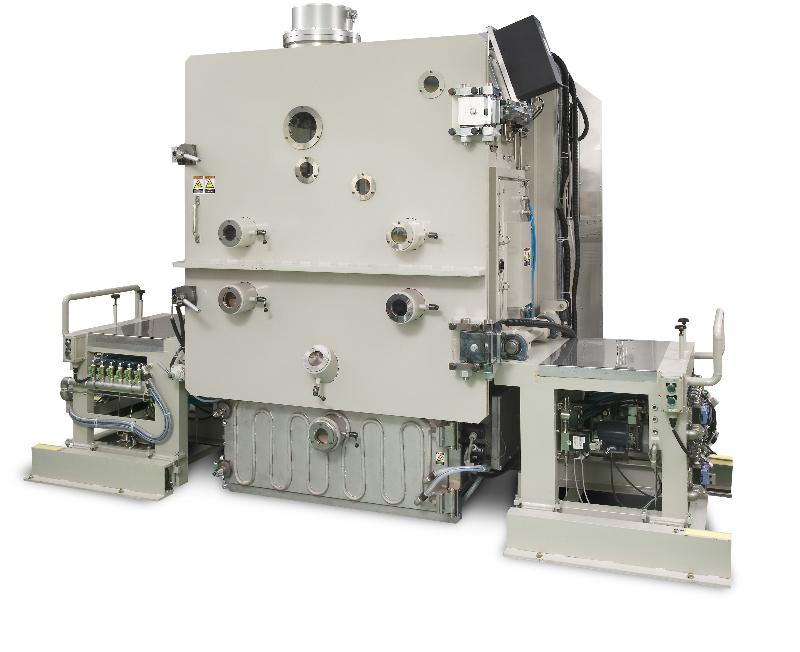
ULVAC's SPW-030 roll coating system is capable of processing 300 mm wide substrate compositions including thin-gauge metal rolls and polymeric materials for R&D and Pilot-scale production. Learn More.
ULVAC Technologies, Inc. Visit Us Online Tel: 1-978-686-7550
E-mail: sales@us.ulvac.com
|

Ferrofluidic Seals
Ferrotec's Ferrofluidic® vacuum feedthroughs set the standard for precision sealing in rotary motion applications. Available in standard sizes or customized for your requirements. Learn more.
http://seals.ferrotec.com
(800) 258-1788
email: info@ferrotec.com
|
 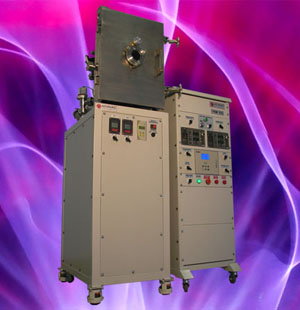
Versatile and Reliable Vacuum Deposition Systems E-beam and thermal evaporation, ion beam and magnetron sputtering for universities and industry, components for PVD and sputtering systems. ROBVAC Fryazino, Moscow Region, Russia Tel: +7 495 966 2814 www.robvac.com |


Automatic Valve Controller The INTELLITROL series of automatic valve controllers provide total control of vacuum operations. It offers fully automatic, protected manual mode and service mode for complete manual operation. Learn More.
YTI Vacuum Coating
Equipment and Service
Phone: 860.429.1908
Intellitrol@ytionline.com
www.ytionline.com
|

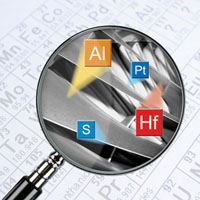
Take Control of Contaminants
Analytical Services Worldwide
Composition | Trace Elements
Thermal Properties
Full Range of Analytical Services
Innovative Analytical Solutions
Phone: 315-431-9900
svc@eaglabs.com
www.eaglabs.com
|

INFICON thin film deposition controllers, monitors and accessories, including customizable sensors and feedthroughs, offer features, function and value targeted to your application. View our catalog and contact us today! |


Rotary Motion Feedthroughs
Rigaku offers a full range of feedthroughs, including low cost SuperseaL, hollow shaft, solid shaft, motorized, UHV, custom designs and competitive direct replacements.
Learn More
Rigaku Vacuum Products
www.rigakuvacuum.com
E-mail: vacuum-info@rigaku.com
Phone: 603-890-6001
|

CLB Power Supply for Variable
Low Frequency
Comdel's proven CLB Series of Low Frequency Power Supplies provide 2500 to 12,000 Watts of power in varying output frequency with a superior design in a small, lightweight package.
Learn more.
Comdel
11 Kondelin Road
Gloucester, MA 01930
Tel: 978-282-0620 or 800-468-3144
Fax: 978-282-4980
www.comdel.com
info@comdel.com
|
|
Now Open!
SVC Digital Library

On-Line Access to the
SVC Annual Technical Conference Proceedings
SEARCH with intuitive features TAG favorite titles
SHARE abstracts via e-mail
DOWNLOAD manuscripts
FREE for members
The database currently contains all manuscripts since 2007. Previous years will continuously be incorporated.
|
|
|

|
|
New Insight Into Early Growth of Solid Thin Films
|
From Brookhaven National Laboratory, May 2013, by Laura Mgrdichian:
"As consumers continue to demand products that are sleeker and faster, understanding the evolution of thin-film growth will help scientists learn to tailor thin films for new technologies. In some cases films grow layer by layer, each layer one atom thick, while in other cases atoms deposited onto a surface form three-dimensional islands that grow, impinge and coalesce into a continuous film. In this latter case, scientists have traditionally assumed that the growing islands are homogeneous, with similar sizes, and coalesce at roughly the same time. However, in a recent study, using x-rays produced at the National Synchrotron Light Source (NSLS), Boston University (BU) researchers investigated island growth in real time, discovering that the process is more dynamic than suggested by the traditional view. The group determined that island evolution matches the behavior predicted by a simple yet detailed model of the deposition, growth, and coalescence of liquid droplets, known as the Family-Meakin (FM) model. Moreover, they propose that other types of thin films grown by the island mechanism may behave the same way during the early stages of growth."
The work is described in Physical Review Letters.
|
|
Moth-Inspired Nanostructures Take the Color Out of Thin Films
|
From North Carolina State University, May 16, 2013 by Matt Shipman:
"Inspired by the structure of moth eyes, researchers at North Carolina State University have developed nanostructures that limit reflection at the interfaces where two thin films meet, suppressing the "thin-film interference" phenomenon commonly observed in nature. This can potentially improve the efficiency of thin-film solar cells and other optoelectronic devices. Thin-film interference occurs when a thin film of one substance lies on top of a second substance. For example, thin-film interference is what causes the rainbow sheen we see when there is gasoline in a puddle of water. Thin-film interference is a problem for devices that use multiple layers of thin films, like thin-film solar cells, because it means that some wavelengths of light are being reflected - or "lost" - at every film interface. The more thin films a device has, the more interfaces  there are, and the more light is lost.
Researchers were inspired by the surface structure of a moth's eye, which has evolved so that it doesn't reflect light. Mimicking that concept, they developed a nanostructure that significantly minimizes thin-film interference. The team found that the an interface featuring the interfacial nanostructures reflects 100 times less light than an interface of thin films without the nanostructures."
The paper was published online in the journal Nanotechnology.
Source: Read the full article...
Image: North Carolina State University
|
|
Researchers Develop Some of the World's Smallest Metallic Nanorods
| From University of Connecticut, May 21, 2013 by Colin Poitras:
"Researchers at University of Connecticut's School of Engineering have grown some of the world's smallest metallic nanorods. They successfully grew noble-metal nanorods 10 nanometers in diameter, which are the smallest ever recorded using physical vapor deposition. Noble-metal nanorods - nanorods made from metals that are resistant to corrosion and oxidation - can be used in microelectronics, powering everything from solar cells to cell phones.

The team discovered that a long-held classical theory for nanorod growth was flawed. The theory held that only single-layer surface steps were stable, and multiple layer surface steps were not, leading to the impossibility of extremely small nanorod growth within the previous theory. But researchers found just the opposite that multilayer surface steps are kinetically stable, and they dictate how subsequent layers of adatoms position themselves. Having nanorods that are clearly separated is also key. When the rods are tightly meshed together, it is difficult to add something to them individually. But if they are well separated, you can put a ring or a coating on them, further enhancing their properties and potential."
The findings were recently published in Physical Review Letters.
|
|
Friction in the Nano-World
|
From Technische Universitaet Muenchen, May 15, 2013: "Whether in vehicle transmissions, hip replacements, or tiny sensors for triggering airbags: The respective components must slide against each other with minimum friction to prevent loss of energy and material wear. Investigating the friction behavior of nanosystems, scientists from the Technische Universitaet Muenchen (TUM) have discovered a previously unknown type of friction that sheds new light on some previously unexplainable phenomena.  Friction is an omnipresent but often annoying physical phenomenon: It causes wear and energy loss in machines as well as in our joints. In search of low-friction components for ever smaller components, a team of physicists led by the professors Thorsten Hugel and Alexander Holleitner now discovered a previously unknown type of friction that they call "desorption stick." Source: Read the full article...
|
|
Dow Lab Safety Academy Launches Free Video Library
|
From The Dow Chemical Company, May 20, 2013:
"At the Council for Chemical Research 2013 Annual Meeting in Arlington, Virginia, among leaders from industry, academia and the National Labs, The Dow Chemical Company unveiled the beta version of the Dow Lab Safety Academy, a digital learning environment that shares Dow's best-in-class industrial safety culture and practices in a quick and accessible format. The Dow Lab Safety Academy includes dozens of videos featuring lab safety guidelines for a variety of real-life scenarios, grouped under four comprehensive lab safety categories.
The website also provides a collection of useful resources such as a chemical reactivity worksheet and an incident alert template, which help promote best practices for safety." The information was developed through pilot programs with U.C. Santa Barbara (UCSB), University of Minnesota and Pennsylvania State University. Explore the Dow Lab Safety Academy at http://safety.dow.comSource: Read the full article...
|
|
Quartz Goes Nano
|
From Chemical and Engineering News, May 20, 2013 by Elizabeth K. Wilson: " Chemists have had little success in miniaturizing the piezoelectric properties of quartz on silicon that produce thin films with piezoelectric properties. Now researchers at the University of Pierre and Marie Curie (Paris) report new synthetic methods for growing quartz crystals ion silicon that produce thin films with piezoelectric properties. Such small-scale piezoelectric materials may be used to develop resonators or as elements or terahertz optics."
Work is published in Science 2013 (DOI:10.1126/science.1232968).Source: Read the full article...
|
Flexible Devices Manufactured by Roll-to-Roll Technologies to Reach Nearly $22.7 Billion by 2017
| |
From Solid State Technology, May 23, 2013:
"The diffusion of roll-to-roll technologies is expected to have a marked effect in lowering the unit prices of flexible devices. Consequently, while consumption in terms of volume is forecast to rise very rapidly, revenues will increase somewhat more moderately. As a result, the total market for roll-to-roll flexible devices is forecast to reach global revenues of nearly $22.7 billion by 2017. The global market for flexible devices manufactured by roll-to-roll technologies increased from $8.5 billion in 2010 to nearly $10 billion in 2011, and was valued at nearly $10.8 billion in 2012.

There are several reasons why flexible devices are gaining increasing importance:- Have same functionalities as traditional (rigid) integrated circuits, yet are produced with low-cost materials and processes.
- Gained increased market share driven by their growing use in popular consumer electronics, such as tablet PCs, RFIDs and smart cards.
- Have reduced package dimensions, reduced weight, and optimization of component real estate."
|
|
Diamonds, Nanotubes Find Common Ground in Graphene
|
From Rice University, May 28, 2013 by Mike Williams:
"What may be the ultimate heat sink is only possible because of yet another astounding capability of graphene. The one-atom-thick form of carbon can act as a go-between that allows vertically aligned carbon nanotubes to grow on nearly anything. That includes diamonds. A diamond film/graphene/nanotube structure was one result of new research carried out by scientists at Rice University and the Honda Research Institute USA. The heart of the research is the revelation that when graphene is used as a middleman, surfaces considered unusable as substrates for carbon nanotube growth now have the potential to do so.
The team grew various types of graphene on copper foil by standard chemical vapor deposition. They then transferred the tiny graphene sheets to diamond, quartz and other metals. Testing found that the graphene layer remains intact between the nanotube forest and the diamond or other substrate. On a metallic substrate like copper, the entire hybrid is highly conductive."
The work was reported in Nature's online journal Scientific Reports.
Source: Read the full article...
|
|
Flexing and Stretching
|
From Information Displays, March/April 2013, Vol. 20, No.2 by Jason C. Heikenfeld:
"So you work in displays? You may soon be working in flexible electronics too. Display engineers are constantly looking for ways to thin down the materials in a display to bring about better aesthetic appeal, impact resistance, and the thinness and lightness required for devices such as smartphones. The point is that if you work in displays, you are often highly qualified to work in flexible/rollable electronics as well. Author Jason Heikenfeld, associate professor with the School of Electronic and Computing Systems at the University of Cincinnati, looks at several of the most interesting developments in flexible electronics.
- American Semiconductor converts advanced ICs from commercial foundries into flexible chips by using their proprietary low-cost FleX Silicon-on-Polymer process and integrating them with printed electronics to form flexible hybrid systems. This new technology is ultra-thin, rugged, bendable, and low cost. Their FleX technology provides logic, memory, and wireless capability that is orders of magnitude faster and smaller than printed TFTs for features that have always been required but never before available in flexible electronics.
- Corning Willow Glass allows processing up to 500°C and is available in samples down to a thickness of 100 µm. This certainly satisfies flexibility and bending down to several centimeters in radius and allows roll-to-roll processing. However, at the present time, it is not yet thin enough for personal foldable or rollable applications, a capability that currently only plastic substrates can provide."
Source: Read the full article...
|
|
Challenges Facing Widespread Implementation of Multi-Touch Technology
|
From Electronic Component News, May 29, 2013, by Ian Crosby, Zytronic:
"The evolution of human-machine interfaces and computer interfaces is underway, with simple button on/button off controls giving way to advanced gesture-based screen interaction requiring so called multi-touch operation.
 Multi-touch technology enables more complex gestures, such as a pinch, zoom, a rotate or a flick, to navigate intuitively through menus and pages on a suitably designed graphic user interface (GUI). It also has the potential to allow multiple users of a screen to share information collaboratively. The vast majority of multi-touch screens used globally are based on projective capacitance (p-cap) sensing, as the technology allows feather-light touch detection and flat, edge-to-edge glass surfaces." Multi-touch technology enables more complex gestures, such as a pinch, zoom, a rotate or a flick, to navigate intuitively through menus and pages on a suitably designed graphic user interface (GUI). It also has the potential to allow multiple users of a screen to share information collaboratively. The vast majority of multi-touch screens used globally are based on projective capacitance (p-cap) sensing, as the technology allows feather-light touch detection and flat, edge-to-edge glass surfaces."
|
The Science of Sculpture, Nano-Style
| | From Northeastern University, June 13, 2013 by Angela
Herring:
"The next breakthrough in highly efficient battery technologies and solar cells may very well be nanoscopic crystals of silicon assembled like skyscrapers on waferscale substrates. An important route for growth of these nanoscale "whiskers" or nanowires involves alloyed metal droplets. 
An associate professor at Northeastern University has been using computational tools to understand the atomic scale interactions between these droplets and the growth of nanowires. The researchers discovered that the droplet does not uniformly wrap around the nanowire. Rather, it coaxes the growing end of the nanowire to facet into unevenly beveled edges.
The study was performed in collaboration with researchers at Lawrence Livermore National Laboratory and Colorado School of Mines. This research is published in the journal Nature Communications."
Source: Read the full article...
|
|
Flexible Opals
| From University of Cambridge (U.K.), May 30, 2013:
"In collaboration with the DKI (now Fraunhofer Institute for Structural Durability and System Reliability) in Germany, researchers from the University of Cambridge have developed a synthetic material which has the same intensity of color as a hard opal, but in a thin, flexible film.
 Instead of through pigments, these 'polymer opals' get their color from their internal structure alone, resulting in pure color which does not run or fade. Additionally, the thin, flexible material changes color when force is exerted on it, which could have potential use in sensing applications by indicating the amount of strain placed on the material. The polymer opals are constructed of spherical nanoparticles bonded to a rubber-like outer shell. When the nanoparticles are bent around a curve, they are pushed into the correct position to make structural color possible." Instead of through pigments, these 'polymer opals' get their color from their internal structure alone, resulting in pure color which does not run or fade. Additionally, the thin, flexible material changes color when force is exerted on it, which could have potential use in sensing applications by indicating the amount of strain placed on the material. The polymer opals are constructed of spherical nanoparticles bonded to a rubber-like outer shell. When the nanoparticles are bent around a curve, they are pushed into the correct position to make structural color possible."
Source: Read the full article...
|
|
Filmmaking Magic with Polymers
| From The University of Akron, June 5, 2013:
"Think about windows coated with transparent film that absorbs harmful ultraviolet sunrays and uses them to generate electricity. Consider a water filtration membrane that blocks viruses and other microorganisms from water, or an electric car battery that incorporates a coating to give it extra long life between charges.
The self-assembled copolymer block film that makes it all possible is now being fabricated with intricately organized nanostructures, giving them multiple functions and flexibility on a macroscale level never before seen.
Gurpreet Singh, a Ph.D. candidate in The University of Akron College of Polymer Science and Polymer Engineering, led a team of researchers to devise a method that enables the films to assemble themselves and allows them to serve as templates or directly as end products. The films can be embedded with nanoparticles that enable everything from data storage to water purification."
Source: Read the full article...
|
Upcoming Conferences of Interest to Vacuum Coaters
|
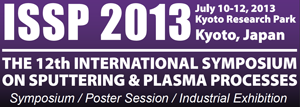 ISSP 2013: The 12th International ISSP 2013: The 12th International
Symposium on Sputtering
& Plasma Processes
July 10-12, 2013, Kyoto Research Park, Kyoto, Japan
Website: http://issp2013.org/

ALD 2013
13th International Conference on Atomic Layer Deposition
July 28-31, 2013, San Diego Marriott Marquis & Marina, San Diego, CA
Website:http://www.ald-avs.org/
|
|
Do You Have an Interesting Article to Share?
|
Interested in sharing the latest news in vacuum coating technology? Forward us a link to an article you want to share with the rest of the SVC readership to publications@svc.org. Purchase advertising space in this newsletter by contacting SVC at 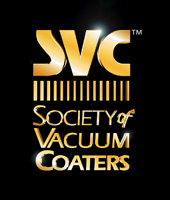 svcinfo@svc.org. svcinfo@svc.org.
Society of Vacuum Coaters
71 Pinon Hill Place NE
Albuquerque, New Mexico 87122
505-856-7188
|
|
|
|
|